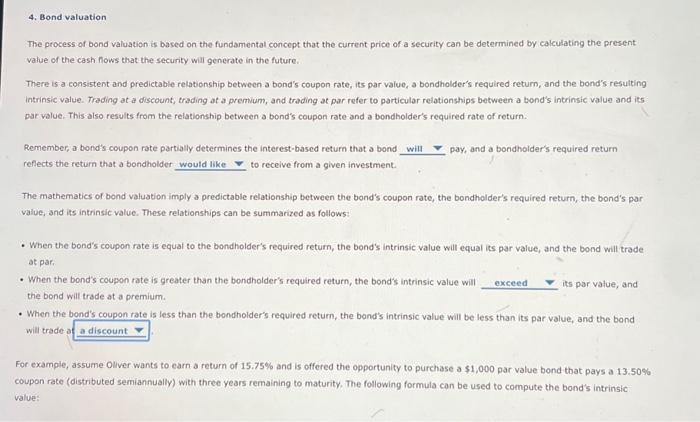Complete the following table by identifying the appropriate corresponding variables used in the equation. Eased on this equation and the data, it is to expect that Oliver's potential bond investment is currently exhibiting an intrinsic value greater than $1,000. Now, consider the situstion in which Oliver wants to earn a return of 16.5%, but the bond being considered for purchase offers a coupon rate of 13.50\%. Again, assume that the bond pays semiannual interest payments and has three years to maturity. If you round the bond's intrinsic value to the nearest whole dollar, then its intrinsic value of bond is (rounded to the nearest whole dollar) is its pdr value, so that the Given your computation and conclusions, which of the following statements is true?? When the coupon rate is less than Oliver's required return, the bond should trade at a discount. When the coupon rate is less than Olver's required return, the intrinsic value will be greater than its par value. A bond should trade at par when the coupon rate is less than Oliver's required return. When the coupon rate is less than Oliver's required return, the bond should trade at a premium. The process of bond valuation is based on the fundamental concept that the current price of a security can be determined by calculating the present value of the cash fows that the security will generate in the future. There is a consistent and predictable relatonship between a bond's coupon rate, its par value, a bondholder's required return, and the bond's resulting intrinsic value. Trading at a discount, trading at a premum, and trading at par refer to particular relationships between a bond's intrinsic value and its par value. This also results from the relationship between a bond's coupon rate and a bondholder's required rate of return. Remember, a bond's coupon rate partially determines the interest-based return that a bond pay, and a bondholder's required return reflects the return that a bondholder to receive from a given investment. The mathematics of bond valuation imply a predictable relationship between the bond's coupon rate, the bondholder's required return, the bond's par value, and its intrinsic value. These relationships can be summarized as follows: - When the bond's coupon rate is equal to the bondholder's required return, the bond's intrinsic value will equal its par value, and the bond will trade at par, - When the bond's coupon rate is greater than the bondholder's required return, the bond's intrinsic value will the bond will trade at a premium. its par value, and - When the bond's coupon rate is less than the bondholder's required return, the bond's intrinsic value will be less than its par value, and the bond will tradie a For example, assume Oliver wants to earn a return of 15.75% and is offered the opportunity to purchase a $1,000 par value bond that pays a 13.50% coupon rate (distributed semiannually) with three years remaining to maturity. The following formula can be used to compute the bond's intrinsic value








